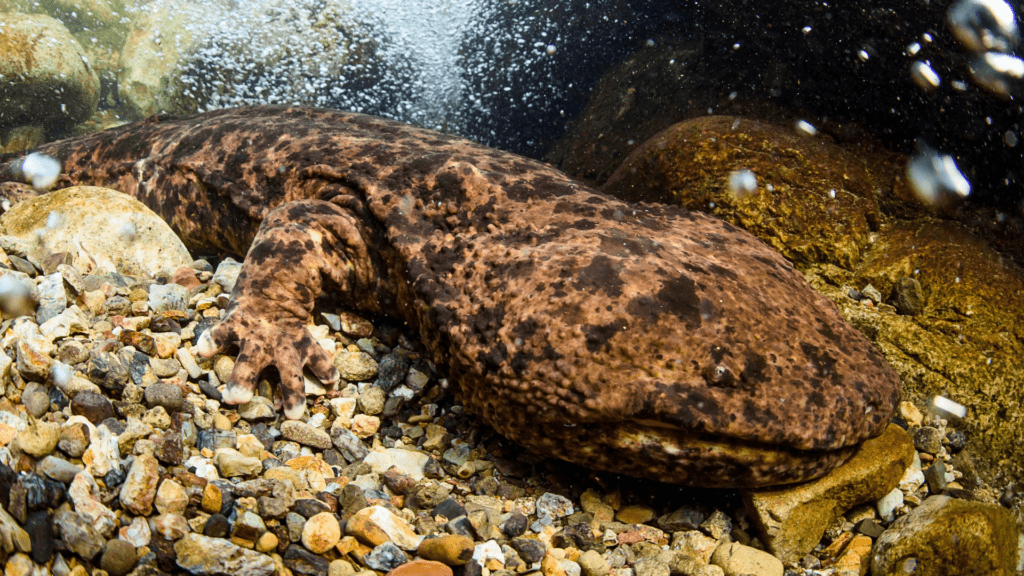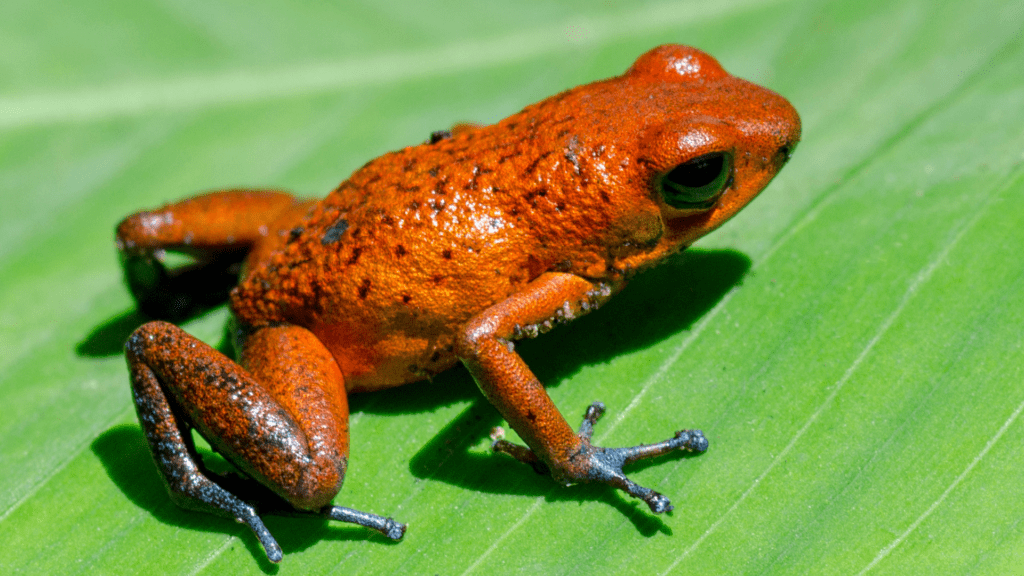The Northern Leopard Frog (Rana pipiens) is a medium-sized amphibian belonging to the True Frog family (Ranidae). These frogs are native to North America, primarily found in the United States and parts of Canada. Known for their striking spotted pattern, they are a popular species both in the wild and as pets.
Scientific Classification
- Kingdom: Animalia
- Phylum: Chordata
- Class: Amphibia
- Order: Anura
- Family: Ranidae
- Genus: Rana
- Scientific Name: Rana pipiens
Physical Characteristics
Size: These frogs grow up to 11 cm (4.3 inches), with females being larger than males. Their tadpoles can reach around 3.5 inches in length.
Coloration: Their dorsal side is dark green or brown, covered with irregular dark spots, earning them the name “Leopard Frog.” They also have cream-colored stripes on their backs, while their ventral side is pale white. Juveniles have fewer spots, and tadpoles display golden dots.
Legs: They have powerful, webbed hind legs, aiding in rapid movement.
Geographic Distribution
Northern Leopard Frogs are native to the northern United States and southern Canada. Their range includes:
- United States: California, Nevada, Nebraska, Oregon, Arizona, Texas, Minnesota, and more.
- Canada: British Columbia, Alberta, Manitoba, and western Ontario.
Habitat Preferences
These amphibians thrive in grasslands with light vegetation and require access to clean water. Common habitats include:
- Streams
- Ponds
- Wet meadows
- Marshes and other wetlands
Diet and Feeding Habits
Northern Leopard Frogs are carnivorous and prey on:
- Crickets
- Worms
- Fish
- Smaller frogs
- Mice and small birds
They have large mouths, enabling them to consume prey nearly their own size.
Behavioral Traits
- Active both during the day (diurnal) and night (nocturnal).
- Roam woodlands and grasslands in summer.
- Seek refuge in water when threatened.
- Employ stillness to avoid predators.
Predators and Threats
These frogs face predation from:
- Birds: Herons, hawks
- Reptiles: Snakes
- Other amphibians: Bullfrogs
- Mammals: Skunks
Tadpoles are particularly vulnerable to fish and water birds.
Adaptations for Survival
- Rapid movement: Can leap 5-6 feet in a zigzag pattern to evade predators.
- Camouflage: Dark green/brown dorsal coloration helps them blend into surroundings.
- Defensive calls: Emit a loud scream when captured, startling predators.
- Efficient hunters: Their speed and jumping ability help them catch prey easily.
Reproduction and Life Cycle
- Breeding season: March to July
- Females reach reproductive maturity at 2-3 years, males at 1-2 years.
- Males call with loud snoring noises to attract females.
- Eggs are laid in clusters (650 to 7,648 per batch), attached to aquatic plants.
- Eggs hatch in 2 to 17 days, depending on temperature.
- Tadpoles metamorphose into frogs within 3 to 6 months.
Lifespan
These frogs live an average of 5 to 8 years in the wild.
Vocalization
Their call resembles the sound of a small motorboat engine. They primarily vocalize at night but may occasionally call during the day. When frightened or captured, they emit a loud, piercing scream.
Hibernation Facts
- Hibernate from October/November to March.
- Seek shelter in mud, semi-frozen lakes, or caves.
- Enter a state of low body temperature and metabolic rate.
Northern Leopard Frog as a Pet
These frogs are relatively easy to care for, making them popular pets.
Housing:
- A 10-gallon tank is sufficient for one frog.
- Half of the tank should contain water, and the other half should be land.
- The terrestrial area should be at least 2-3 inches deep for burrowing.
- A wooden platform provides a suitable basking spot.
Water Requirements:
- Use dechlorinated water.
- Avoid water filters that create excessive vibrations.
- Change 50% of the water at least twice a week.
Temperature & Lighting:
- Ideal daytime temperature: 20-24°C (68-75°F).
- Lower nighttime temperature to 16°C (60°F).
- No special lighting required, but moderate UV exposure is beneficial.
Diet:
- Feed a variety of small insects (flies, beetles, crickets, worms).
- Occasionally consume fruits and vegetables.
- Provide vitamin supplements weekly.
- Best fed once every two days.
Handling:
- Avoid handling unless necessary.
- Wash hands thoroughly after contact.
Interesting Facts
State Amphibian: This amphibian holds the title of the official state amphibian in both Minnesota and Vermont, reflecting its significance and widespread presence in these regions.
Alternative Name: Often referred to as the “Grass Frog” due to its love for grassy meadows and fields, this nickname highlights its natural habitat preference.
Group Name: When gathered in groups, these frogs are known as an “Army.” This term evokes the image of their large, tightly-knit groups, particularly during breeding seasons.
Similar Species: With strikingly similar markings, these amphibians are frequently confused with Pickerel Frogs. Despite their similarities, they have distinct behaviors and environmental preferences.
Conservation Status
- Classified as Least Concern by the IUCN.
- Some U.S. states consider them “Threatened” due to habitat loss and pollution.
Final Thoughts
The Northern Leopard Frog is a fascinating species, known for its striking appearance and unique behaviors. Whether in the wild or as a pet, this amphibian continues to intrigue researchers and enthusiasts alike. Understanding their ecology and conservation needs is essential for preserving their populations in the future.
faq’s
What taxonomic classification does the Northern Leopard Frog belong to?
The Northern Leopard Frog (Rana pipiens) belongs to the Kingdom Animalia, Phylum Chordata, Class Amphibia, Order Anura, Family Ranidae, and Genus Rana.
What are the key physical characteristics that distinguish Northern Leopard Frogs?
They have a green or brown dorsal side covered with irregular dark spots, giving them a “leopard” appearance. Their ventral side is pale white, and they have powerful webbed hind legs that allow them to leap great distances.
What are the primary environmental conditions required for their survival?
These frogs thrive in grasslands, wetlands, ponds, and streams with clean water. They prefer environments with light vegetation and access to both terrestrial and aquatic habitats.
How does the Northern Leopard Frog’s diet contribute to its ecological role?
As carnivores, they regulate insect populations by consuming crickets, worms, and beetles. They also prey on small vertebrates like fish, frogs, and even mice, playing a crucial role in maintaining ecological balance.
What are the major predators of the Northern Leopard Frog?
Their predators include birds (herons, hawks), reptiles (snakes), amphibians (bullfrogs), and mammals (skunks). Tadpoles are especially vulnerable to predation by fish and water birds.
How do Northern Leopard Frogs adapt to avoid predation?
They use camouflage, rapid zigzag jumping (covering up to 6 feet in one leap), and loud distress calls to evade predators. Their ability to stay motionless also helps them avoid detection.
What is the reproductive strategy of Northern Leopard Frogs?
They breed in aquatic environments between March and July. Males attract females with snoring-like calls, and females lay clusters of 650–7,648 eggs in water. Eggs hatch within 2–17 days, and tadpoles undergo metamorphosis in 3–6 months.
How does temperature affect their life cycle and development?
Egg incubation and tadpole development rates depend on water temperature. Higher temperatures accelerate hatching and metamorphosis, sometimes shortening tadpole development to just 50 days.
What role does hibernation play in their survival?
Northern Leopard Frogs hibernate from October/November to March by burrowing in mud, submerging in lakes, or seeking caves. Their metabolism slows significantly to conserve energy during harsh winters.
Why are Northern Leopard Frogs considered a species of conservation concern in some regions?
Although classified as Least Concern globally, habitat destruction, pollution, climate change, and disease outbreaks (e.g., chytridiomycosis) have led to population declines in certain U.S. states, where they are considered “Threatened.
References
https://californiaherps.com/frogs/pages/l.pipiens.html
http://animals.nationalgeographic.com/animals/amphibians/northern-leopard-frog/
http://allaboutfrogs.org/info/species/leopard.html
http://exoticpets.about.com/cs/frogsandtoads/a/leopardfrogs.htm
https://www.fws.gov/species/northern-leopard-frog-rana-pipiens

